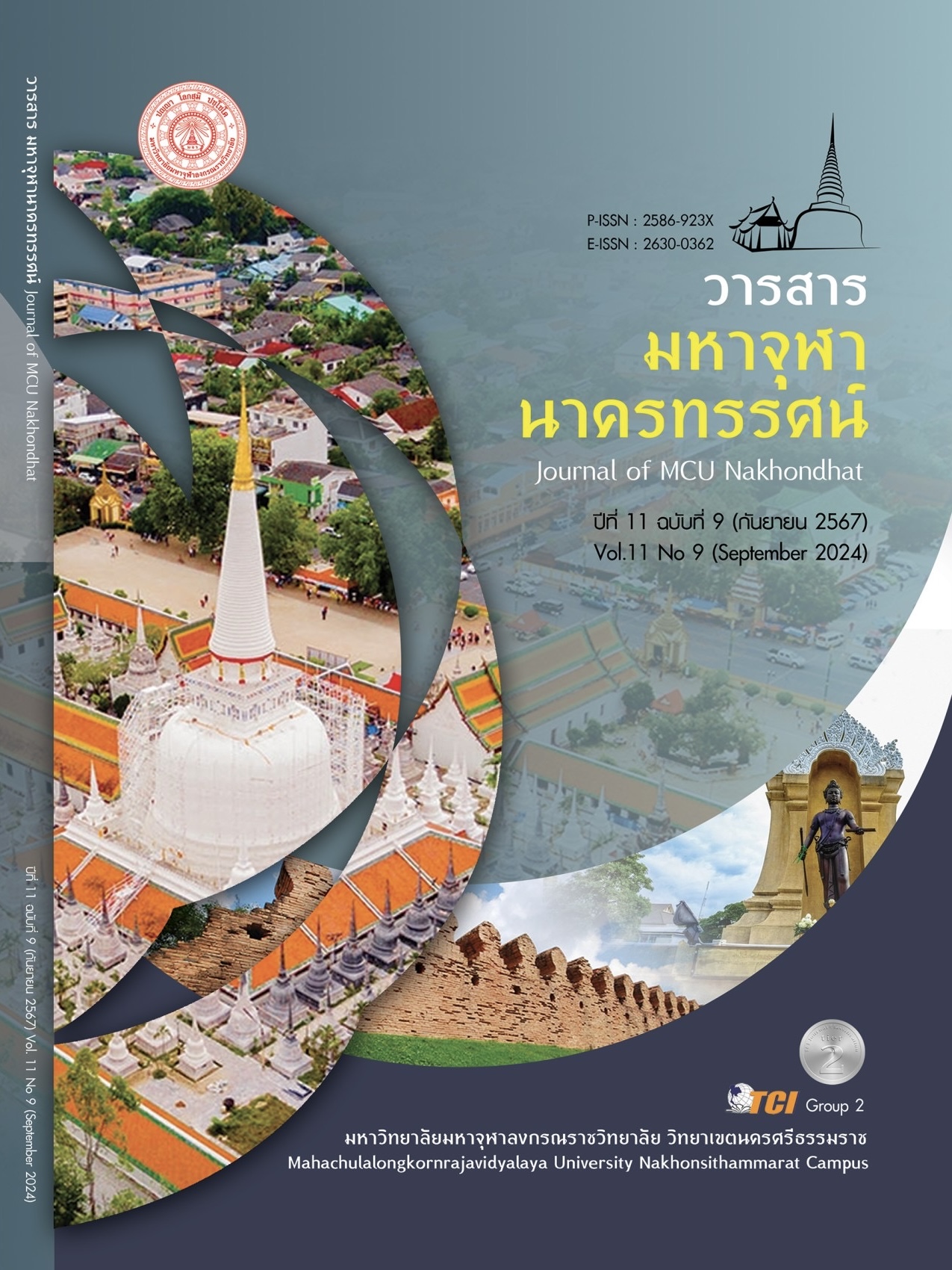FUNERAL WREATHS: REFLECTIONS ON POWER RELATIONS IN THAI SOCIETY
Main Article Content
Abstract
This research article aimed to study: 1) The origins of offering funeral wreaths in Thai society, and 2) The context of power relations within the political sphere, as expressed through the forms of communication and symbolism found in funeral wreaths. The study employed a qualitative research approach, selecting key informants through purposive sampling. The selected informants included 2 monks, 2 wreath shop owners, 1 religious ceremony master, 5 funeral hosts, 5 politicians and government officials who offered wreaths, and 5 funeral attendees, totaling 20 individuals. In-depth interviews were utilized as the primary data collection tool, and the findings were analyzed using descriptive analysis. The study revealed that: 1) The tradition of offering funeral wreaths originated from Western culture, where wreaths were used in both auspicious and inauspicious ceremonies. This practice was introduced to Thai society during the reign of King Rama IV, specifically for use in funerals, replacing the traditional offerings of flowers, incense, and candles. Initially, wreaths were used primarily in the funerals of the elite and later became more common among the general population. The early wreaths consisted of simple branches woven together as a symbol of mourning for the deceased. Over time, funeral wreaths evolved to become symbols of power and status. 2) The context of power relations is embedded within the social customs and symbolism associated with funeral wreaths. These wreaths signify the identity and social standing of the giver and their group, reflecting the social and political relationships between the deceased, the deceased's family, and the giver. Furthermore, funeral wreaths have served as a subtle political tool, providing politicians with an opportunity to communicate and campaign, using the funeral as a platform to introduce themselves and promote their political parties-a practice that continues to the present day.
Article Details

This work is licensed under a Creative Commons Attribution-NonCommercial-NoDerivatives 4.0 International License.
References
แขกผู้ที่มาร่วมในงานศพ. (1 พฤษภาคม 2565). พวงหรีดงานศพ: บทสะท้อนความสัมพันธ์เชิงอำนาจในสังคมไทย. (พระทวี หอมเกตุ, ผู้สัมภาษณ์)
คณาจารย์ มหาวิทยาลัยมหาจุฬาลงกรณราชวิทยาลัย. (2558). คู่มือ ประโยค ป.ธ.3 อรรถกถาธรรมบท ภาค 5 แปลโดยอรรถ. กรุงเทพมหานคร: โรงพิมพ์มหาจุฬาลงกรณราชวิทยาลัย.
เจ้าภาพผู้จัดงานศพ. (19 เมษายน 2565). พวงหรีดงานศพ: บทสะท้อนความสัมพันธ์เชิงอำนาจในสังคมไทย. (พระทวี หอมเกตุ, ผู้สัมภาษณ์)
เจ้าอาวาสวัดมหัตตมังคลาราม (วัดหาดใหญ่ใน). (15 พฤษภาคม 2565). พวงหรีดงานศพ: บทสะท้อนความสัมพันธ์เชิงอำนาจในสังคมไทย. (พระทวี หอมเกตุ, ผู้สัมภาษณ์)
ธงชัย สมบูรณ์. (2552). การเมืองในพวงหรีด. เรียกใช้เมื่อ 21 ธันวาคม 2564 จาก http://www.edu.ru.ac.th/images/edu_files/politics.pdf
นงลักษณ์ เกตุบุตร และพรทิพย์ เย็นจะบก. (2554). การวิเคราะห์ภาพในการหาเสียงเลือกตั้ง ปีพ.ศ. 2554 ผ่านเว็บไซต์เฟซบุ๊กดอทคอม. ใน การประชุมทางวิชาการของมหาวิทยาลัยเกษตรศาสตร์ ครั้งที่ 50: สาขาศึกษาศาสตร์, สาขาเศรษฐศาสตร์และบริหารธุรกิจ, สาขามนุษยศาสตร์และสังคมศาสตร์ (หน้า 354-361). กรุงเทพมหานคร: มหาวิทยาลัยเกษตรศาสตร์.
บุญมี แก้วตา และคณะ. (2562). ศึกษาความสัมพันธ์ระหว่างหลักไตรลักษณ์กับหลักความผาสุกทางจิตวิญญาณ. วารสารพุทธศาสตร์ศึกษา, 10(2), 447-461.
ปราณี วงษ์เทศ. (2534). พิธีกรรมเกี่ยวกับการตายในประเทศไทย. กรุงเทพมหานคร: อมรินทร์พรินติ้ง.
ผู้ช่วยเจ้าอาวาสวัดมหัตตมังคลาราม (วัดหาดใหญ่ใน). (16 พฤษภาคม 2565). พวงหรีดงานศพ: บทสะท้อนความสัมพันธ์เชิงอำนาจในสังคมไทย. (พระทวี หอมเกตุ, ผู้สัมภาษณ์)
รุจิราภา งามสระคู. (2560). การพัฒนาต้นแบบพวงหรีดเพื่อสิ่งแวดล้อมโดยการมีส่วนร่วมของชุมชน. ใน รายงานการวิจัย. มหาวิทยาลัยราชภัฏพระนคร.
เสฐียร โกเศศ. (2551). ประเพณีเกี่ยวเนื่องในการตาย. (พิมพ์ครั้งที่ 4). กรุงเทพมหานคร: ศยาม.
เสฐียร ทั่งทองมะดัน และสานิตย์ ศรีนาค. (2563). การตีความคำสอนเรื่องอิทัปปัจจยตาในทัศนะของพุทธทาสภิกขุ. วารสาร มจร พุทธศาสตร์ปริทรรศน์, 4(1), 39-54.
Davies, D. J. (2002). Death, Ritual and Belief: The Rhetoric of Funerary Rites. London: Bloomsbury Academic.
Gennep, A. V. (1960). The Rites of Passage. Chicago, United States of America: University of Chicago Press.
Miles, M. B. & Huberman, A. M. (1994). Qualitative Data Analysis: An Expanded Sourcebook. Thousand Oaks, London: Sage Publications, Inc.
Turner, V. (1967). The Forest of Symbols: Aspects of Ndembu Ritual. Ithaca, New York: Cornell University Press.


